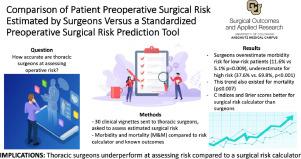Seminars in Thoracic and Cardiovascular Surgery ( IF 2.6 ) Pub Date : 2021-11-13 , DOI: 10.1053/j.semtcvs.2021.11.008 Adam R Dyas 1 , Kathryn L Colborn 2 , Michael R Bronsert 3 , William G Henderson 4 , Nicholas J Mason 1 , Paul D Rozeboom 1 , Nisha Pradhan 1 , Anne Lambert-Kerzner 3 , Robert A Meguid 3

|
Considerable variability exists between surgeons’ assessments of a patient's individual preoperative surgical risk. Surgical risk calculators are not routinely used despite their validation. We sought to compare thoracic surgeons’ prediction of patients’ risk of postoperative adverse outcomes vs a surgical risk calculator, the Surgical Risk Preoperative Assessment System (SURPAS). We developed vignettes from 30 randomly selected patients who underwent thoracic surgery in the American College of Surgeons’ National Surgical Quality Improvement Program database. Twelve thoracic surgeons estimated patients’ preoperative risks of postoperative morbidity and mortality. These were compared to SURPAS estimates of the same vignettes. C-indices and Brier scores were calculated for the surgeons’ and SURPAS estimates. Agreement between surgeon estimates was examined using intraclass correlation coefficients (ICCs). Surgeons estimated higher morbidity risk compared to SURPAS for low-risk patients (ASA classes 1–2, 11.5% vs 5.1%, P ≤ 0.001) and lower morbidity risk compared to SURPAS for high-risk patients (ASA class 5, 37.6% vs 69.8%, P < 0.001). This trend also occurred in high-risk patients for mortality (ASA 5, 11.1% vs 44.3%, P < 0.001). C-indices for SURPAS vs surgeons were 0.84 vs 0.76 (P = 0.3) for morbidity and 0.98 vs 0.85 (P = 0.001) for mortality. Brier scores for SURPAS vs surgeons were 0.1579 vs 0.1986 for morbidity (P = 0.03) and 0.0409 vs 0.0543 for mortality (P = 0.006). ICCs showed that surgeons had moderate risk agreement for morbidity (ICC = 0.654) and mortality (ICC = 0.507). Thoracic surgeons and patients could benefit from using a surgical risk calculator to better estimate patients’ surgical risks during the informed consent process.
中文翻译:

胸外科医生估计的术前手术风险与标准化手术风险预测工具的比较
外科医生对患者个体术前手术风险的评估存在相当大的差异。尽管经过验证,但手术风险计算器并未常规使用。我们试图将胸外科医生对患者术后不良后果风险的预测与手术风险计算器手术风险术前评估系统 (SURPAS) 进行比较。我们从 30 名随机选择的接受过美国外科医师学会国家外科质量改进计划数据库中的胸外科。十二名胸外科医生评估了患者术前的术后发病率和死亡率风险。这些与 SURPAS 对相同小插曲的估计进行了比较。为外科医生和 SURPAS 估计计算了 C 指数和 Brier 分数。使用组内相关系数 (ICC) 检查外科医生估计值之间的一致性。与 SURPAS 相比,外科医生估计低风险患者的发病风险更高(ASA 1-2 级,11.5% 对 5.1%, P ≤ 0.001),而与 SURPAS 相比,高风险患者的发病风险更低(ASA 5 级,37.6% 对69.8%, P < 0.001)。这种趋势也发生在高死亡率患者中 (ASA 5, 11.1% vs 44.3%, P< 0.001)。SURPAS 与外科医生的 C 指数的发病率分别为 0.84 和 0.76 ( P = 0.3),死亡率分别为 0.98 和 0.85 ( P = 0.001)。SURPAS 与外科医生的 Brier 评分在发病率方面分别为 0.1579 和 0.1986 ( P = 0.03),在死亡率方面分别为 0.0409 和 0.0543 ( P = 0.006)。ICC 显示外科医生对发病率 (ICC = 0.654) 和死亡率 (ICC = 0.507) 具有中度风险一致性。胸外科医生和患者可以受益于使用手术风险计算器在知情同意过程中更好地估计患者的手术风险。











































 京公网安备 11010802027423号
京公网安备 11010802027423号